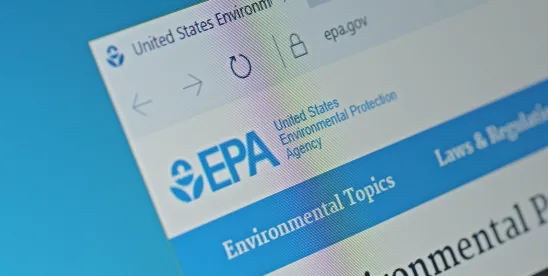On May 8, 2024, the U.S. Environmental Protection Agency’s (EPA) Office of Chemical Safety and Pollution Prevention (OCSPP) held a webinar on “Reducing PFAS in Products: Progress and Challenges.” The webinar was the third in EPA’s series on “Pollution Prevention in Action.” Jennie Romer, EPA Deputy Assistant Administrator for Pollution Prevention, hosts webinars featuring businesses, Pollution Prevention grantees, and other experts about innovations and successes in implementing source reduction strategies to advance sustainability across sectors. EPA will post a recording of the May 8, 2024, webinar on its website. Recordings of previous webinars are already available.
The May 8, 2024, webinar included the following speakers:
- Zach Schafer, EPA’s Office of Water;
- Jenna Larkin, EPA’s Office of Chemical Safety and Pollution Prevention (OCSPP);
- Saskia van Bergen, Washington Department of Ecology (WDOE);
- Ning Ai, University of Illinois-Chicago; and
- Mike Schade, Toxic-Free Future.
Schafer provided an overview of EPA’s PFAS Strategic Roadmap: EPA’s Commitments to Action 2021-2024. As reported in our May 9, 2024, memorandum, in April 2024, EPA issued the final National Primary Drinking Water Regulation (NPDWR) for six per- and polyfluoroalkyl substances (PFAS) and announced the availability of funding to help water systems remove PFAS. Also in April 2024, EPA designated perfluorooctanoic acid (PFOA), perfluorooctanesulfonic acid (PFOS), and their salts and structural isomers as hazardous substances under the Comprehensive Environmental Response, Compensation, and Liability Act (CERCLA). More information on the final rule is available in our April 23, 2024, memorandum.
Larkin provided information on how the Biden-Harris Administration has been addressing PFAS in products, including:
- Recent enhancements to EPA’s online search tool for its Recommendations of Specifications, Standards, and Ecolabels for Federal Purchasing. The tool includes a new feature to highlight how the standards and ecolabels address PFAS. Consistent with the federal government’s goal to avoid procurement of products containing any type of PFAS, EPA no longer highlights ecolabels or standards that address only individual chemicals like PFOA and PFOS;
- EPA’s April 8, 2024, announcement that it is directing government contractors to purchase cleaning products for federal buildings that are free of PFAS;
- The General Services Administration’s (GSA) April 16, 2024, request for information (RFI) exploring opportunities to reduce or eliminate potential PFAS “with the intent to reduce exposure from products offered to the Government through GSA’s contract solutions”; and
- The April 22, 2024, final rule amending the Federal Acquisition Regulation (FAR) to restructure and update the regulations to focus on current environmental and sustainability matters. The final rule requires federal agencies to procure products certified by EPA’s WaterSense® and Safer Choice programs.
Ai described a new initiative funded by EPA’s Pollution Prevention Grant: Environmental Justice Through Safer and More Sustainable Products that will promote environmental and health justice through sustainable food service products.
van Bergen described how WDOE is addressing PFAS, including through Safer Products for Washington. WDOE provides resources for small businesses, the public, and product manufacturers. WDOE also offers financial support for product certifications.
Schade reviewed the results of a 2022 report entitled Toxic Convenience: The hidden costs of forever chemicals in stain- and water-resistant products. According to Schade, several brands and retailers are phasing out PFAS in textiles. Schade noted that an ecolabel does not necessarily mean that the label addresses the entire PFAS class.
Commentary
The webinar provided an overview of the ways that the Biden-Harris Administration is addressing PFAS in consumer products. Webinar participants highlighted a number of resources available, while noting that not all ecolabels are equivalent, with some covering PFAS while others address only certain ones, such as PFOA and PFOS. Stakeholders are urged to review the information made available by EPA and consider opportunities to diminish PFAS in consumer products to the extent possible.



 />i
/>i

